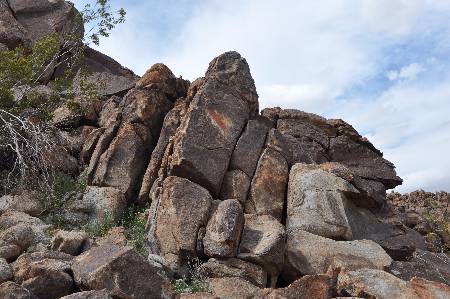Desert Varnish Study Proposal: Andrew Bishop
The great desert of the west is an iconic American landscape, large swathes of which are coated by the distinctive red-brown layers of desert varnish. This surface deposit consists of multiple layers of organic material interspersed with manganese and iron oxides. Its widespread occurrence reflects one of the most quantitatively significant distinctive geochemical processes on Earth, but a phenomenon considered enigmatic by most geoscientists. Much is now known of what constitutes desert varnish and how it forms, as well as some indications of its environmental significance. It has the potential to be an essential record of paleoclimatic change in desert environments, a setting mostly lacking the availability of such proxies. Starting this summer, UCR research associate Dr. Andrew Bishop will begin studies detailed below.
Environmental Significance
It is postulated that the dark, manganese-rich layers in desert varnish form during wetter climatic intervals (Broecker and Liu, 2001). Thus, the layering may reflect climatic variation on the century to millennium scale. In these examples, the potential climate record represents the latest Pleistocene through the Holocene, spanning an interval of substantial global temperature change. Bishop’s research will address the hypothesis that desert varnishes and their lamina contain a proxy for determining desert paleoclimatic conditions. If so, this work will enable a robust deconvolution of Holocene climate change across the desert southwest. Such an understanding would provide fundamental calibration for estimates of future climate change across this region.
The primary objective of the evaluation will be to determine if the lamina patterns observed are consistent and reproducible at multiple, disparate locations around the Coachella Valley. A statistical approach will be employed to ensure that lamination intervals are compared systematically and objectively. Once the ages of the lamination are also determined and correlated, we will determine whether they show a direct linkage to other patterns of regional environmental change (e.g. Salton Trough lacustrine intervals) and global paleoclimate trends (including comparison with Holocene climate models).
Nature and Character of Desert Varnish
Fig. 1 shows photomicrographs of desert varnish (plane polarized light), for two locations in California (a. Searles Lake; b. Panamint Lake), as published by Liu and Broecker (2007). The thickness of these varnish examples is ca. 250mm, with total dated maximum ages of 16,800 and 18,400 years respectively. Distinct layering is evident in both these examples, which appears to be a typical characteristic. The light layers are composed primarily of clay minerals and organic matter, whereas the darker laminae are dominated by birnessite (a manganese oxide mineral).
Proposed Work Program
To test if the desert varnish is applicable to paleoclimate investigations, a streamlined validation/calibration study is proposed, utilizing locations in and around the Coachella Valley.
Sample locations
- Recent extrusive volcanics, which have or can be reliable dated, provide an absolute maximum varnish age, e.g. Rhyolite dome, southern Salton Sea
- Previously characterized locations described in the external literature, allow direct comparison of published examples with in-house data
- Notable locations of geographic significance, affording early impact results, e.g. dating the age of major alluvial fans in proximity to urban development
Analytical Work Plan
Samples will be characterized primarily at UCR using available instrumentation.
- Conventional Microscopy
- Thin sections will be examined using the standard facilties available in Earth Sciences
- Reflected light microscopy will be conducted in association with collaborators at Southern Illinois (Prof. Sue Rimmer): This analysis represents a novel application.
- Scanning Electron Microscopy
- Utilizing the facilities of the microscopy group at UCR, prepared polished blocks will be characterized by backscatter imagery and elemental mapping
- Stable Isotope analyses and Radiocarbon Dating
- Organic matter concentrations, isotopic compositions, as well as dating will be performed
- Organic matter concentrations, isotopic compositions, as well as dating will be performed
This study will provide a fundamental test of the efficacy of these methods to study the relationship of desert varnish to paleoclimatic conditions, and if successful, provide a springboard for broader application across this region. If proved useful, the application of organic petrography for desert varnish characterization would be a notable discovery. Similarly, the demonstration that alluvial fans in the Coachella Valley can be reliably dated would be an important insight for local stakeholders in the community and would in all likelihood lead to many more such studies.


